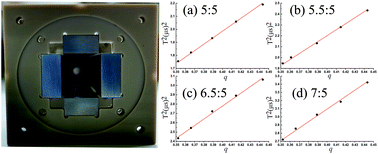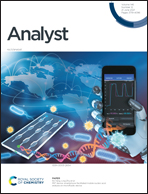Measurement of the effective electric field radius on digital ion trap spectrometer†
Abstract
The effective electric field radius is a fundamental parameter of ion traps, and it has a significant influence on ion-trapping capability, signal intensity, mass range and some other properties of the ion trap. For a quadrupole ion trap built with ideal hyperbolic electrodes, its effective electric field radius can be obtained by its geometrical size, while it is very difficult to obtain the effective electric field radius for a non-hyperbolic ion trap. In this study, the effective electric field radius of a linear ion trap and some ceramic rectilinear ion traps (cRITs) were investigated via the digital ion trap technology. The dipole frequency of supplementary AC for excitation was locked at a certain value of the main RF trapping wave, and the characteristic q values for excitation could be determined accordingly. The q values could be further used to calculate the effective electric field radius through theoretical calculations. A linear equation had been fitted between the q values for excitation and the square of period T2 through experiments subsequently. The relative deviation between the measured electric field radius and the simulative electric field radius is less than 2%. The simulation results and experimental validation show that the approach has predictive power for modeling and measuring the effective field radius of non-hyperbolic ion traps. It is certainly significant for further understanding the performances of non-hyperbolic quadrupole systems.

- This article is part of the themed collection: 150th Anniversary Collection: Mass Spectrometry


 Please wait while we load your content...
Please wait while we load your content...